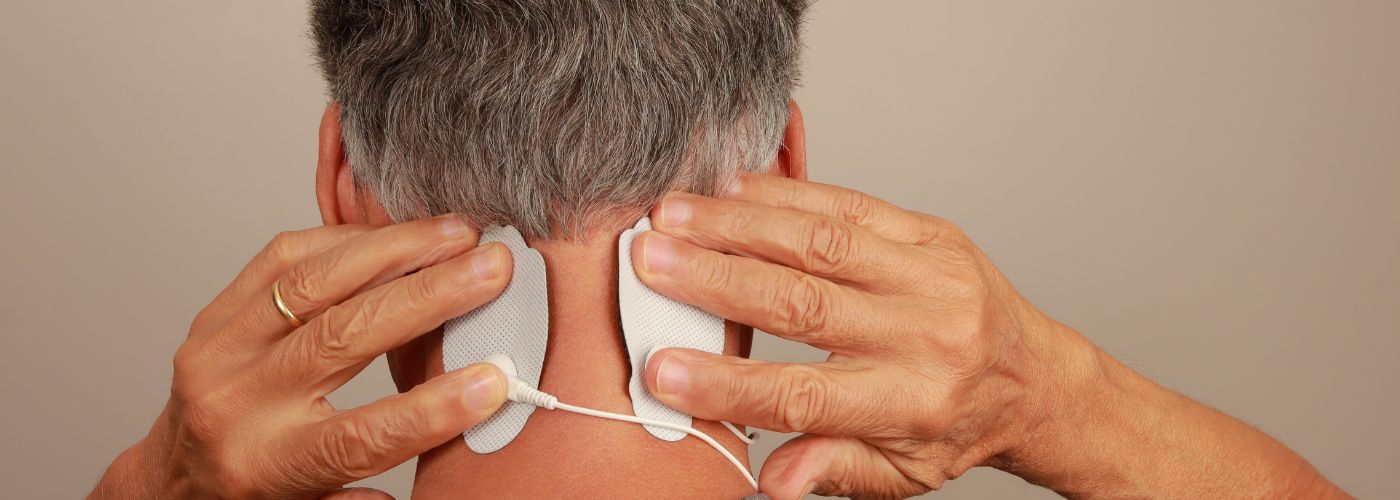Imagine a world where the pounding ache of a headache may be eased with the simple touch of a button. For many, this dream is becoming a reality through Transcutaneous Electrical Nerve Stimulation (TENS), a therapy that harnesses low-voltage electrical currents to block pain signals and promote relaxation. We’ll explore how many people are using TENS for headaches.
Can You Use TENS For Headaches?
Transcutaneous Electrical Nerve Stimulation (TENS) has emerged as a fascinating alternative for managing headaches, offering an innovative twist to traditional pain relief methods.
Many people are surprised to learn that TENS may be effectively used to target headache pain, particularly tension and migraine headaches.

The technique involves placing electrodes on the skin, which emit low-voltage electrical pulses designed to stimulate nerves and block pain signals from reaching the brain. This treatment not only potentially helps in reducing acute pain but may also encourage relaxation and alleviate muscle tension common in headache syndromes.
What sets TENS apart is its non-invasive nature, providing a drug-free option for those wary of pharmaceutical side effects or dependency issues. Moreover, some users report enhanced mood alongside reduced headache intensity—possibly due to the release of endorphins stimulated by this therapy.
Optimal TENS Placements For Migraines
The effectiveness of TENS therapy hinges significantly on electrode placement, which can be strategically positioned to target specific trigger points associated with migraine discomfort. For instance, many users find relief by placing electrodes on the nape of the neck and the temples, as these areas are often linked with tension and pain pathways.
However, exploring beyond traditional placements can yield surprising results. Placing electrodes on the forearm may stimulate nerve pathways that promote overall relaxation and enhance blood circulation throughout the upper body.
Some research suggests that targeting acupressure points—such as LI4 (located between the thumb and index finger)—can also produce beneficial outcomes by alleviating tension before it escalates into a full-blown headache.
Ultimately, experimenting with various application sites allows individuals to tailor their TENS therapy experience!
Other Treatments To Increase TENS Migraine Therapy
Incorporating complementary therapies may enhance the efficacy of TENS for headaches, creating a more holistic approach to migraine management. One promising option is mindfulness meditation, which has been shown to reduce stress and emotional triggers associated with migraines.
By pairing TENS therapy with mindfulness practices, patients may experience not only reduced pain but also greater emotional resilience against future migraine episodes.
Another avenue worth exploring is the use of dietary adjustments and hydration strategies alongside TENS treatments.
Research suggests that certain food triggers can exacerbate headaches; therefore, adopting an anti-inflammatory diet rich in fatty acids and antioxidants may significantly decrease migraine frequency.
Staying well-hydrated is equally crucial; dehydration can intensify headache symptoms. When combined with consistent TENS sessions, these lifestyle changes could create a synergistic effect that bolsters overall treatment outcomes.
Finally, incorporating physical therapy or gentle exercises like yoga or static stretching can serve to improve overall circulation and muscle tension relief. Together, these strategies enable patients to build a robust toolkit for managing their migraines more effectively than ever before.
How Long Should Your TENS Migraine Therapy Be?
When considering TENS for headaches, one critical aspect to explore is the duration of therapy. Most experts recommend a session length of 20 to 30 minutes, striking a balance between efficacy and comfort.
This timeframe is often sufficient for the electrical stimulation to penetrate deep enough into the tissue, promoting blood flow and alleviating pain without overwhelming the nervous system. However, individual responses can vary significantly; some may find relief with shorter sessions while others might benefit from extending their use up to an hour.

It’s also valuable to observe how frequency interacts with duration in TENS treatment for migraines. Consistency plays a key role in reaping long-term benefits; thus, incorporating TENS therapy into your daily routine could lead to progressive improvements over time.
Overall, always speak with your primary care doctor about the use of TENS for headaches or migraines.
Recommended Settings For Your TENS Device
When it comes to utilizing a TENS device for headaches, personalized settings can make all the difference in effectively managing pain. Start by setting the frequency between 80 to 120 Hz, which is generally recommended for acute pain relief.
This higher frequency stimulates sensory nerves and can help distract from headache discomfort. However, many users find success with alternating frequencies; lower settings around 2 to 10 Hz may promote deeper muscle relaxation and reduce tension that often contributes to headache episodes.
Another critical aspect is determining the optimal duration of your sessions. For maximum efficacy, aim for short bursts of about 20-30 minutes at a time; this allows your body to adapt without over-stimulation.
When To Get Help For Your Migraines & Headaches
Migraines and headaches can often feel like an unbearable burden, but knowing when to seek help is crucial for managing these conditions effectively.
If you find that over-the-counter medications no longer alleviate your pain, or if you’re experiencing headaches more than a few times a month, it’s time to consult a healthcare professional.
Frequent episodes may indicate an underlying condition that requires personalized treatment—whether it be prescription medication or alternative therapies such as TENS for headaches, which can provide relief by blocking pain signals.
Moreover, pay attention to accompanying symptoms—visual disturbances, nausea, or sensitivity to light could signal the severity of your condition. Keeping a headache diary might reveal patterns linked to diet or stressors that are not immediately obvious.

Related Stories
Pickleball vs. Tennis: The Science of Recovery
For years, tennis was the stand-in for movement: endurance, coordination, and power all at once....
Oct
5 Ways to Support Bone Strength with HiDow
World Osteoporosis Day (October 20) October 20 is World Osteoporosis Day, and chances are, you’ve...
Oct
FDA-Cleared Is a Flex. Here’s Why.
Pulling Back the Curtain You’ve seen it on boxes, on websites, in ads: FDA-cleared. It...
Sep
This Is Fibro. This Is Larry.
September is Pain Awareness Month. And we’re not here to give you medical definitions or...
Sep
Train Your Relaxation Reflex
How often do you find yourself struggling to switch off after a long day? With...
Aug
Back To School Fitness: Balancing Academics & Athletics
Most student athletes don’t have a motivation problem. They show up. They train hard. They...
Aug